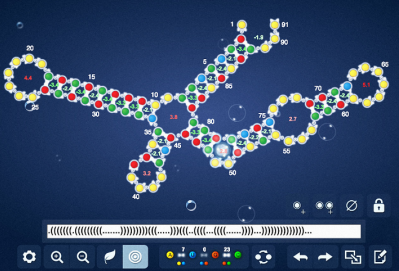These Gamers Helped Create A Scientific Breakthrough About The Building Blocks Of Life
Published February 18, 2016 on Fast Company
Without ever entering a lab, Jeff Anderson-Lee, a computer systems manager with no biology training beyond high school classes, is helping researchers understand the molecular foundation of all life on Earth. Anderson-Lee avidly plays Eterna, an online puzzle game that requires players to fold pixelated strands of RNA into complex molecular shapes using the real-life rules of chemical bonding.
RNAs are single strands of nucleotides that can bend and fold into molecules that perform all sorts of useful functions in the body—from ferrying genetic information between parts of the cell to switching genes on or off. Being able to create RNA molecules that perform certain tasks, like turning off genes related to a specific genetic disorder, could help researchers develop vaccines, eradicate some rare diseases, and create new therapies for neurological disorders and cancers. But harnessing RNA like that requires researchers to be able to predict what shape a specific RNA sequence will fold into, which is a large and tough equation to figure out.
That’s where Eterna comes in. Built by researchers at Stanford and Carnegie Mellon universities in 2010, the game presents players with a target molecular shape and rules modeled off of the ones Mother Nature uses to build that structure. Players fill in the individual nucleotides with hopes of creating stable designs and advancing to the next puzzle. Once they complete the tutorial puzzles, players design molecules that can solve actual biochemical problems. Thousands of player designs are periodically sent to Stanford, where they’re synthesized to find out how nature actually folds those sequences. The underlying science is complicated, but hardcore academic knowledge isn’t necessary to play, which means that even the most scientifically-challenged amongst us can make valuable biochemistry contributions—and publish the results.
This week, Anderson-Lee, along with fellow Eterna player Eli Fisker, became thefirst gamers to publish research as lead authors in a peer-reviewed scientific journal. The research started as a series of Google Docs where top players could dump their knowledge about particularly hard puzzles. Noticing certain trends, like the fact that symmetrical puzzles are generally harder than asymmetrical ones of the same length, Anderson-Lee, Fisker, and fellow gamers devised a system players can use to figure out how difficult it is to build certain RNA molecules. Though the system was designed solely for gamers, scientists can also use it as a tool to sidestep design problems when building RNA molecules of their own. The results will be released in the Journal of Molecular Biology.
“It could accelerate research if we explain to biomedical researchers, ‘Hey, you’ve got this snowflake-shaped RNA you’re trying to make? Well it turns out highly symmetric shapes are actually difficult to design, so how about you make an asymmetric version of a snowflake?’” says Rhiju Das, co-creator of Eterna and head of Stanford University’s Das Lab which tested the gamers’ results against six different puzzle-solving algorithms, none of which could solve all of the puzzles the Eterna community could.
The Eterna research comes right in the midst of “an RNA revolution.” Scientists are discovering that the nucleotide chains play a bigger role in the cell than previously thought, says Alain Laederach, a biologist who studies RNA structure and folding at the University of North Carolina at Chapel Hill. New gene editing technologies have also pushed the macromolecules to center stage, as biotech companies scramble to develop targeted RNA therapies and treatments for diseases ranging from cancers to rare genetic disorders. Laederach, who was not involved in the Eterna research, says that the new categorization system can not only help guide future research, it can also provide scientists with valuable insight into molecular evolution.
“Now that we know which [RNA molecules] are harder to design, we can better understand what features of that molecule that nature has evolved that are important and why this particular molecule has a fold in it,” he says. “…if [nature] has evolved a symmetric molecule, that’s pretty darn cool. You know how hard that was.”






